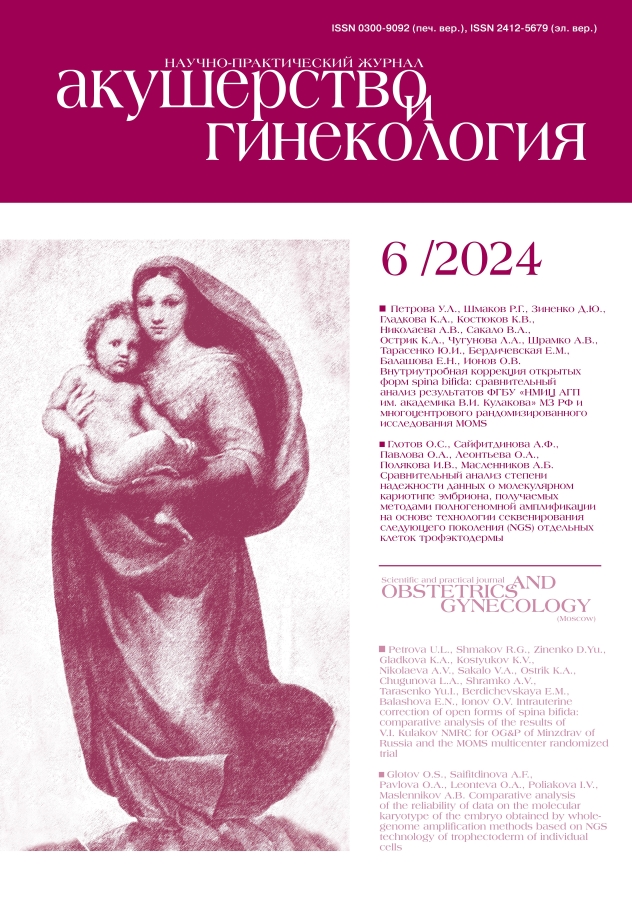Ультразвуковые возможности диагностики в экспериментальной модели задержки роста плода
- Авторы: Беспалова О.Н.1, Блаженко А.А.1, Коптеева Е.В.1, Пачулия О.В.1, Шелаева Е.В.1, Коган И.Ю.1
-
Учреждения:
- ФГБНУ «Научно-исследовательский институт акушерства, гинекологии и репродуктологии имени Д.О. Отта»
- Выпуск: № 6 (2024)
- Страницы: 56-64
- Раздел: Оригинальные статьи
- Статья опубликована: 21.06.2024
- URL: https://journals.eco-vector.com/0300-9092/article/view/634341
- DOI: https://doi.org/10.18565/aig.2024.24
- ID: 634341
Цитировать
Полный текст
Аннотация
Цель: Оценка эффективности экспериментальной модели задержки роста плода (ЗРП) на внутриутробном этапе с использованием ультразвукового отслеживания параметров фетометрии и допплерометрии кроликов Oryctolagus cuniculus.
Материалы и методы: В исследование были включены 16 самок Оryctolagus cuniculus (8 для моделирования ранней ЗРП, 8 – для поздней ЗРП). УЗИ проводилось на 20-й и 27-й день гестации кроликов с оценкой окружности головы (ОГ), окружности живота (ОЖ), длины бедра (ДБ) и пульсационного индекса (ПИ) артерии пуповины.
Результаты: На 20-й день гестации наименьшие значения ОГ (41,0 (IQR 39,5–42,1) мм), ОЖ (48,8 (IQR 46,7–49,7) мм) и ДБ (4,7 (IQR 4,68–4,82) мм) наблюдались в экспериментальной группе ранней ЗРП по сравнению с контролем (р<0,001). В то же время у плодов из экспериментальной группы ЗРП отмечалось повышение ПИ артерии пуповины по сравнению с группой контроля (1,87 против 1,56 соответственно, р<0,001). Схожая тенденция наблюдалась и на 27-й день гестации. Все параметры фетометрии (ОГ, ОЖ, ДБ) были значимо снижены у плодов с ранней ЗРП по сравнению с контролем и поздней ЗРП. Отмечалось повышение ПИ артерии пуповины у плодов с ранней ЗРП (как экспериментальной (2,48, IQR 2,15–2,75), так и контрольной группы (2,44, IQR 2,30–2,56)) по сравнению с моделью поздней ЗРП (р<0,001). При моделировании поздней ЗРП отмечалось повышение ПИ артерии пуповины в экспериментальной группе по сравнению с группой контроля (1,83 против 1,57 соответственно, р<0,001).
Заключение: Селективное лигирование маточно-плацентарных сосудов является эффективным методом моделирования ЗРП у кролика, а использование УЗИ на внутриутробном этапе позволяет подтвердить, что проведенная операция была успешной и вызвала тяжелую плацентарную недостаточность.
Полный текст
Об авторах
Олеся Николаевна Беспалова
ФГБНУ «Научно-исследовательский институт акушерства, гинекологии и репродуктологии имени Д.О. Отта»
Email: shiggerra@mail.ru
ORCID iD: 0000-0002-6542-5953
д.м.н., заместитель директора по научной работе
Россия, Санкт-ПетербургАлександра Александровна Блаженко
ФГБНУ «Научно-исследовательский институт акушерства, гинекологии и репродуктологии имени Д.О. Отта»
Автор, ответственный за переписку.
Email: alexandrablazhenko@gmail.com
ORCID iD: 0000-0002-8079-0991
к.м.н., м.н.с. отдела фармакологии
Россия, Санкт-ПетербургЕкатерина Вадимовна Коптеева
ФГБНУ «Научно-исследовательский институт акушерства, гинекологии и репродуктологии имени Д.О. Отта»
Email: ekaterina_kopteeva@bk.ru
ORCID iD: 0000-0002-9328-8909
м.н.с. отдела акушерства и перинатологии
Россия, Санкт-ПетербургОльга Владимировна Пачулия
ФГБНУ «Научно-исследовательский институт акушерства, гинекологии и репродуктологии имени Д.О. Отта»
Email: for.olga.kosyakova@gmail.com
ORCID iD: 0000-0003-4116-0222
к.м.н., ученый секретарь
Россия, Санкт-ПетербургЕлизавета Валерьевна Шелаева
ФГБНУ «Научно-исследовательский институт акушерства, гинекологии и репродуктологии имени Д.О. Отта»
Email: eshelaeva@yandex.ru
к.м.н., с.н.с. отдела акушерства и перинатологии
Россия, Санкт-ПетербургИгорь Юрьевич Коган
ФГБНУ «Научно-исследовательский институт акушерства, гинекологии и репродуктологии имени Д.О. Отта»
Email: ikogan@mail.ru
ORCID iD: 0000-0002-7351-6900
д.м.н., профессор, чл.-корр. РАН, директор
Россия, Санкт-ПетербургСписок литературы
- Burton G.J., Jauniaux E. Pathophysiology of placental-derived fetal growth restriction. Am. J. Obstet. Gynecol. 2018; 218(2S): S745-S761. https:// dx.doi.org/10.1016/J.AJOG.2017.11.577.
- Bertholdt C., Dap M., Pillot R., Chavatte-Palmer P., Morel O., Beaumont M. Assessment of placental perfusion using contrast-enhanced ultrasound: a longitudinal study in pregnant rabbit. Theriogenology. 2022; 187: 135-40. https://dx.doi.org/10.1016/J.THERIOGENOLOGY.2022.05.002.
- Coombs P., Walton S.L., Maduwegedera D., Flower R.L., Denton K.M. Fetal growth and well-being in a study of maternal hypertension in rabbits. Anat. Rec. (Hoboken). 2020; 303(10): 2646-56. https://dx.doi.org/10.1002/ AR.24344.
- Lopez-Tello J., Arias-Alvarez M., Gonzalez-Bulnes A., Sferuzzi-Perri A.N. Models of intrauterine growth restriction and fetal programming in rabbits. Mol. Reprod. Dev. 2019; 86(12): 1781-809. https://dx.doi.org//10.1002/MRD.23271.
- López-Tello J., Barbero A., González-Bulnes A., Astiz S., Rodríguez M., Formoso-Rafferty N. et al. Characterization of early changes in fetoplacental hemodynamics in a diet-induced rabbit model of IUGR. J. Dev. Orig. Health Dis. 2015; 6(5): 454-61. https://dx.doi.org/10.1017/S2040174415001385.
- Mourier E., Tarrade A., Duan J., Richard C., Bertholdt C., Beaumont M. et al. Non-invasive evaluation of placental blood flow: lessons from animal models. Reproduction. 2017; 153(3): R85-R96. https://dx.doi.org/ 10.1530/REP-16-0428.
- Liu Z., Foote R.H. Effects of amino acids on the development of in-vitro matured/in-vitro fertilization bovine embryos in a simple protein-free medium. Hum. Reprod. 1995; 10(11): 2985-91. https://dx.doi.org/10.1093/ oxfordjournals.humrep.a135834.
- Christians E., Boiani M., Garagna S., Dessy C., Redi C.A., Renard J.P. et al. Gene expression and chromatin organization during mouse oocyte growth. Dev. Biol. 1999; 207(1): 76-85. https://dx.doi.org/10.1006/DBIO.1998.9157.
- Chavatte-Palmer P., Laigre P., Simonoff E., Chesné P., Challah-Jacques M., Renard J.P. In utero characterisation of fetal growth by ultrasound scanning in the rabbit. Theriogenology. 2008; 69(7): 859-69. https://dx.doi.org/10.1016/ J.THERIOGENOLOGY.2007.12.013.
- Hodges R., Endo M., La Gerche A., Eixarch E., DeKoninck P., Ferferieva V. et al. Fetal echocardiography and pulsed-wave Doppler ultrasound in a rabbit model of intrauterine growth restriction. J. Vis. Exp. 2013; (76): 50392. https://dx.doi.org/10.3791/50392.
- DeKoninck P., Endo M., Sandaite I., Richter J., De Catte L., Van Calster B. et al. A pictorial essay on fetal rabbit anatomy using micro-ultrasound and magnetic resonance imaging. Prenat. Diagn. 2014; 34(1): 84-9. https://dx.doi.org/10.1002/PD.4259.
- Herrera E.A., Alegría R., Farias M., Díaz-López F., Hernández C., Uauy R. et al. Assessment of in vivo fetal growth and placental vascular function in a novel intrauterine growth restriction model of progressive uterine artery occlusion in guinea pigs. J. Physiol. 2016; 594(6): 1553-61. https://dx.doi.org/ 10.1113/JP271467.
Дополнительные файлы
















